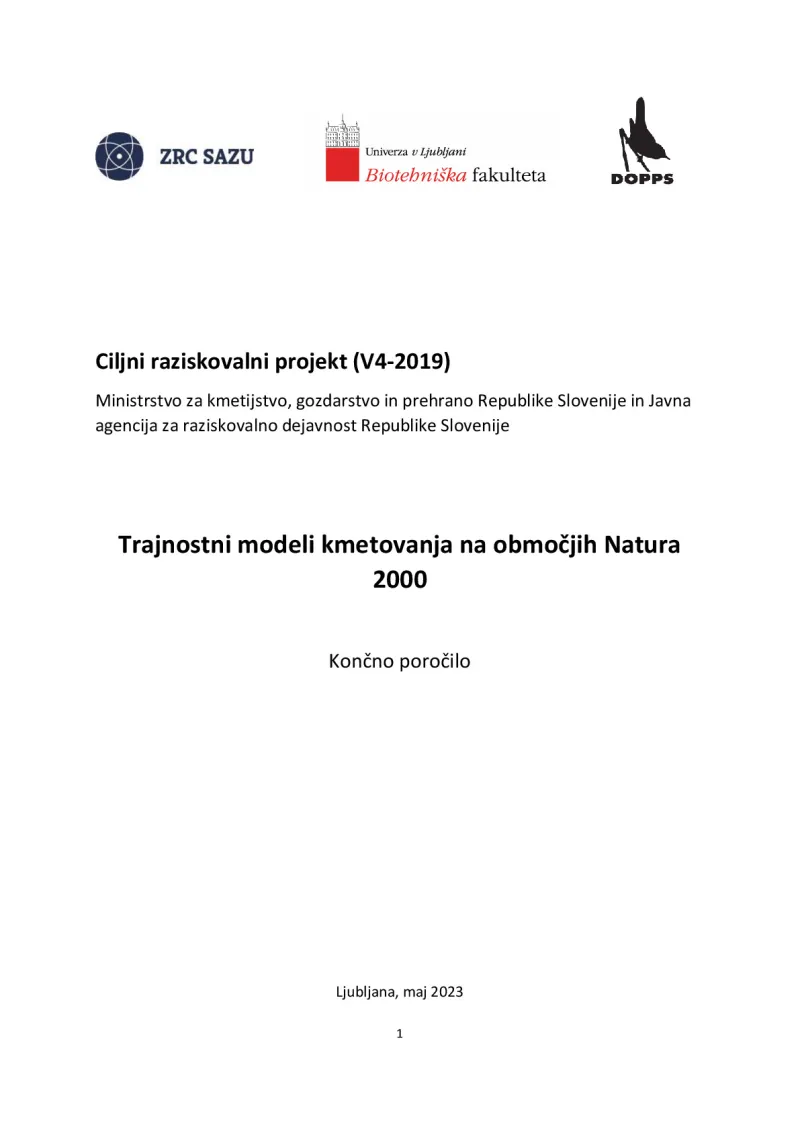Sustainable farming models in Natura 2000 areas in Slovenia
The study reports on the research project and aims to analyse whether sustainable farming models can be established in Natura 2000 pilot areas that will also enable the achievement of biodiversity conservation objectives.
- Slovenia
- 2014-2022
- Environmental impacts


This is the final report of a research project implemented by the Research Centre of the Slovenian Academy of Sciences and Arts, the Biotechnical Faculty of the University of Ljubljana, and DOPPS—BirdLife Slovenia. The project, for which the final report was produced, analyses in a comprehensive and multidisciplinary way whether it is possible to establish sustainable farming models in Natura 2000 pilot areas that will, in addition to achieving economic and production objectives, also enable the achievement of biodiversity conservation objectives.
Funded by the Slovenian Ministry of Agriculture, Forestry and Food and Research and Innovation Agency, the research study aimed at: i) defining policies and measures for the conservation of selected qualifying bird species, butterflies and habitat types in Natura 2000 sites; ii) identifying nature protection, production and socioeconomic needs and objectives in two selected Natura 2000 sites; iii) analysing the possibilities for introducing targets; iv) checking the readiness of agricultural holdings to adapt agricultural practices and accept market valorisation; v) developing a set of guidelines for sustainable farming in selected Natura 2000 sites, integration of Natura 2000 management into agricultural policy planning; vi) reviewing options for the creation of the 'Natura 2000' brand and possibilities for defining the criteria for granting Natura 2000 farm status and improving communication with farms in Natura 2000 sites.
An overview of qualification species of birds, butterflies and habitat types was made and in total, 38 species of birds, 12 species of butterflies and 18 habitat types were selected.
For a pilot test of the definition of sustainable farming models, an overview of available spatial bases was made. Model agricultural holdings were defined based on focus groups with local agricultural advisors and experts in ecology and nature protection. The agricultural holdings model (MKMG), a tool that enables a variety of analyses at the level of the farm production plan was applied and upgraded.
To evaluate biodiversity and farmers’ willingness to adapt farming practices in Natura 2000 sites, a survey was carried out.
Nature protection market schemes were explored to explore opportunities for the market valorisation of ecosystem services in agriculture and the organisation of producers in Natura 2000 sites. An exploratory analysis of study cases was conducted to gain a detailed understanding of the criteria and organisation of market nature protection schemes.
Regarding sustainable farming models, the implementation of zoning and the preparation of detailed protection objectives and orientations are hampered by the scarcity and obsolescence of data sources and by the lack of more detailed ecological research and research on the effectiveness of various measures. In some areas, there is still a lack of targeted research to identify the ecological needs of qualifying species and to develop technological orientations on farms. The lack of research is particularly evident in the impact of different agricultural practices on the conservation status of qualifying species and habitat types.
The basic message of the research project is that the harmonisation of nature protection and production objectives depends on various factors. Effective management of Natura 2000 sites requires careful analysis of local conditions and specific management and support plans.
The research, among other things, concludes that for most farms in the analysed areas, the adjustment of production to the minimum and moderate nature conservation requirements is still economically manageable, especially if certain production adjustments are made on the farm, which are supported by targeted public support.
The new measures should be primarily linked to habitat types and the differences between the groups of Natura 2000 sites identified in the project should be further taken into account. The next step should be to prepare a more detailed analysis of the production and economic characteristics of model agricultural holdings on individual groups of areas, which can serve as a basis for planning development policies and targeted investment, income and nature protection support.
The decision-making of farmers takes place in a complex social environment, which includes the economic and production framework, living conditions and motivation, social norms and others. Addressing all these aspects is crucial to accelerate the transition to sustainable farming models. Among the farmers interviewed, a productive view of farming prevails, which in turn significantly defines the social norms associated with the 'good farmer'. Social norms play an important role in decision-making on Slovenian farms, as comparisons between farmers affect social capital.
The current system of management of protected areas and Natura 2000 sites in Slovenia is likely to have a limited positive impact on changes in social norms or may even operate in the opposite direction.
Author(s)
Research Centre of the Slovenian Academy of Sciences and Arts, Biotehnical Faculty of the Univeristy of Ljubljana and DOPPS – BirdLife Slovenia> Urban Šilc, Tatjana Čelik, Branko Vreš,Tanja Šumrada, Živa Alif, Ana Novak, Andreja Beci, Jaka Žgajnar, Emil Erjavec, Katarina Denac, Primož Kmecl, Blaž Blažič
Resources
Documents
Sustainable farming models in Natura sites 2000
(PDF – 5.24 MB – 125 pages)